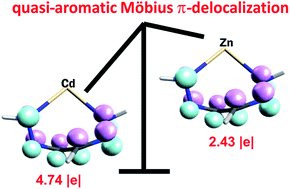Structural versatility of the quasi-aromatic Möbius type zinc(ii)-pseudohalide complexes – experimental and theoretical investigations†
Abstract
In this contribution we report for the first time fabrication, isolation, structural and theoretical characterization of the quasi-aromatic Möbius complexes [Zn(NCS)2LI] (1), [Zn2(μ1,1-N3)2(LI)2][ZnCl3(MeOH)]2·6MeOH (2) and [Zn(NCS)LII]2[Zn(NCS)4]·MeOH (3), constructed from 1,2-diphenyl-1,2-bis((phenyl(pyridin-2-yl)methylene)hydrazono)ethane (LI) or benzilbis(acetylpyridin-2-yl)methylidenehydrazone (LII), respectively, and ZnCl2 mixed with NH4NCS or NaN3. Structures 1–3 are dictated by both the bulkiness of the organic ligand and the nature of the inorganic counter ion. As evidenced from single crystal X-ray diffraction data species 1 has a neutral discrete heteroleptic mononuclear structure, whereas, complexes 2 and 3 exhibit a salt-like structure. Each structure contains a ZnII atom chelated by one tetradentate twisted ligand LI creating the unusual Möbius type topology. Theoretical investigations based on the EDDB method allowed us to determine that it constitutes the quasi-aromatic Möbius motif where a metal only induces the π-delocalization solely within the ligand part: 2.44|e| in 3, 3.14|e| in 2 and 3.44|e| in 1. It is found, that the degree of quasi-aromatic π-delocalization in the case of zinc species is significantly weaker (by ∼50%) than the corresponding estimations for cadmium systems – it is associated with the Zn–N bonds being more polar than the related Cd–N connections. The ETS-NOCV showed, that the monomers in 1 are bonded primarily through London dispersion forces, whereas long-range electrostatic stabilization is crucial in 2 and 3. A number of non-covalent interactions are additionally identified in the lattices of 1–3.



 Please wait while we load your content...
Please wait while we load your content...